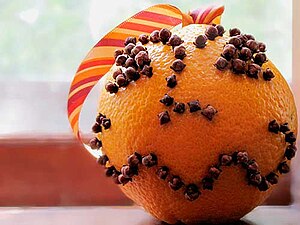
Pomanders are a form of nature craft that have been made for centuries. At its most basic, a pomander consists of the use of citrus fruit as a base into which cloves are inserted. This forms the base, after which the pomander is "cured" or "set" with an array of spices. The spices chosen can vary, hence there can be different types of pomander made.
Duration of the pomander will depend on how well the citrus fruit was cured and the local environment in which the pomander is kept.
Making pomanders is an enjoyable craft for kids and adults alike, as it's something that is tactile and scented, and it's pleasing to the eye when completed.
When completed, the pomander can be rested in a container such as a bowl or jar, it can be hung with ribbon, twine or other material, or it can be placed inside a basket, box or other container for placing inside a cupboard to impart its scent.
Choosing the citrus fruit[edit | edit source]
Begin with the selection of the citrus fruit. It can be an orange, grapefruit, lemon, lime, cumquat, tangerine, etc., provided its of a good size (meaning, you're able to hold and see it with ease) and shape (whatever pleases your eye). It should be free of blemishes and not dented anywhere. The best citrus for making a pomander from is firm skinned and while it's probably easier if the skin is thin, if you're strong and don't mind pushing those cloves into thicker citrus skin, that's fine too.

Purchase a container of whole cloves (if you grow your own, then use those). For an average sized orange, for example, around 60 to 80g of cloves should suffice. Always have more than you think you'll need, to be on the safe side.
Making the spice mix[edit | edit source]
For the spices, you'll need to make a spice mixture using your favourite spices. There is no single "right" mix here, you can experiment to your heart's content, but here's a basic suggestion to get you started:
- 30g orris root powder, (orris root is an important setting powder used in potpourri)
- 25g cinnamon, ground
- 20g nutmeg, ground
- 20g allspice, ground
- 10g cloves, ground (can't get enough of this scent!)
- Mix the spices together in a mixing bowl.
- Transfer to an airtight glass jar or other container.
- Use for making pomanders. This amount will cover at least 10 and maybe more pomanders.
Making the pomander[edit | edit source]
Decide whether you want to use your fingers to poke the cloves in (they'll get sore fairly quickly), a thimble on the end of a finger or a tool to make the holes, such as a knitting needle or skewer. The tool is recommended as it's easier to pierce the orange skin and saves your fingers. It's also a better locus of control for most people, but that's a personal thing.
If using your fingers, push the clove straight in, up to its head. If using a tool, pierce the skin with the tool, then push the clove in, up to its head. The next hole should be spaced about 1/2 cm from the first hole. Use the same technique that works for you. Don't squeeze too much, try to keep the fruit firm.
Continue adding cloves in this manner until the entire orange is covered. It's likely that you'll work out your own process for speeding things up as you go, such as poking a row of holes, then inserting cloves, or doing a section and having a cup of tea and checking the veggie patch, then coming back to it. Or, share the task with the kids at the table. Just be sure to complete it in the same day as you started it because if the fruit isn't covered with cloves, it'll rot quickly.
If you are tying ribbon around the citrus fruit, leave space for the ribbon to go on, such as a strip of skin without cloves running downward.
Curing with the spices[edit | edit source]
Tip the spices out onto a small saucer. Roll the clove-studded fruit over and over in the spices. Pick some of the spice up in your fingertips and sprinkle it over the fruit as well. Just make sure it's really well covered in spices. Continue this spice-coating process daily for the following weeks, as the pomander dries out. Leave in a dry, well-ventilated place to dry out. Depending on your local temperatures, it can take up to a month to dry out thoroughly. You'll know it's done when the fruit is rock hard to the touch.
Wrap with ribbon and a hanging piece or bow if adding such. Alternatively, place in a bowl, box, basket or other receptacle and place where it will impart its fragrance. If you make a few, turn them into an interesting arrangement of some sort.
Pomanders can also be sold at school fairs, festive market stalls and in stores stocking herb and decorative items.